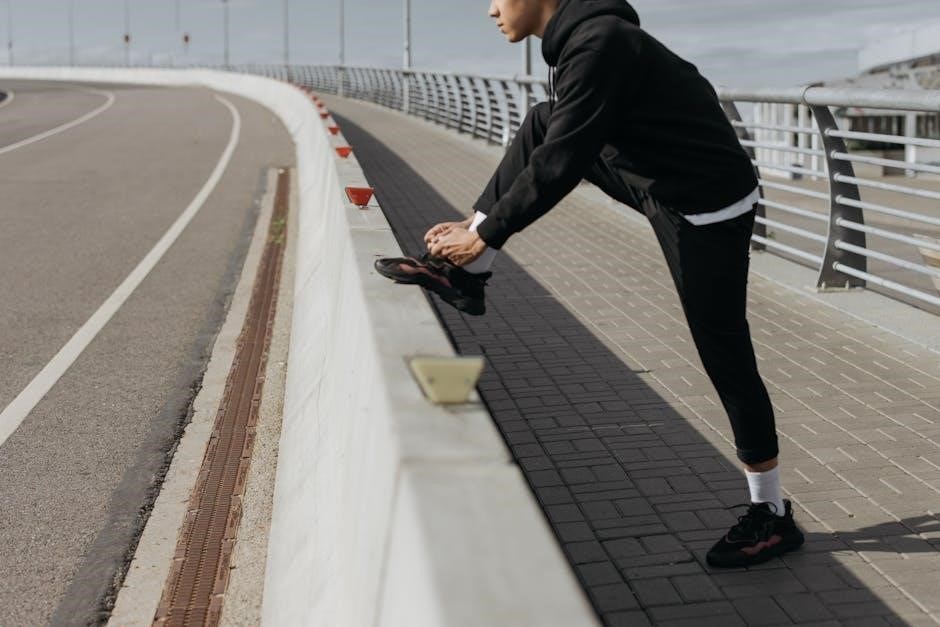tie dye socks instructions
Tie-dye socks are a fun and creative DIY project that allows individuals to express their personal style through unique, colorful designs. Easy and rewarding, they make a great addition to anyone’s wardrobe with minimal effort.
Why Tie-Dye Socks Are Popular
Tie-dye socks have gained immense popularity due to their vibrant, unique designs that add a personal touch to outfits. They’re easy to create, making them a fun DIY project for all skill levels. The small size of socks simplifies the dyeing process, allowing for quick results. Tie-dye socks also offer a way to express individuality and confidence through bold, colorful patterns. Their versatility ensures they can complement casual or statement-making looks. Additionally, the creative process of making them is therapeutic and rewarding, making tie-dye socks a trendy and enjoyable accessory for many.
Benefits of Making Tie-Dye Socks at Home
Making tie-dye socks at home offers numerous advantages, including cost-effectiveness and customization. You can choose colors and patterns that match your style, creating unique designs not found in stores. The process is also time-efficient, requiring minimal preparation and quick dyeing steps. Additionally, it’s a great way to upcycle old socks, reducing waste. The DIY nature of the project makes it a fun and educational activity for families or individuals, fostering creativity and self-expression. Plus, homemade tie-dye socks make thoughtful, personalized gifts for loved ones.

Materials Needed for Tie-Dye Socks
- White cotton socks (preferably 100% cotton for best results)
- Rubber bands for creating patterns
- Tie-dye powder or one-step dye kits
- Soda ash or fixative (if not using one-step dye)
- Protective gloves and eyewear
- Plastic wrap or a wire rack
- Water and applicator bottles
Best Type of Socks for Tie-Dye
For optimal results, use 100% cotton socks, as they absorb dye best and produce vibrant colors. Avoid synthetic materials like nylon or polyester, as they don’t dye effectively. Socks with 50-70% cotton can work but may yield lighter shades. Choose plain white socks to ensure bright, visible colors. Longer socks are ideal for beginners, as they’re easier to fold and manipulate. Avoid small or ankle socks, as they’re harder to work with. Ensure socks are clean and free of residue before dyeing for the best absorption.
Essential Supplies for Tie-Dye
Gather necessary supplies for tie-dyeing socks, including white cotton socks, rubber bands, dye (fiber-reactive or one-step kits), fixer or soda ash, gloves, and protective gear. Use applicator bottles for precise dye application. Cover your workspace with plastic or newspaper. Optional items like aprons, goggles, and face masks ensure safety. Kits often include dye, gloves, and applicators, simplifying preparation. Have water and a washing area nearby. Proper supplies ensure a smooth, enjoyable tie-dye experience with professional-looking results.
Recommended Dyes and Fixatives
Fiber-reactive dyes are ideal for tie-dye socks, offering vibrant, long-lasting colors that bind well with cotton. Tulip one-step tie-dye kits are highly recommended, as they include fixatives, eliminating the need for soda ash. For manual mixing, use soda ash as a fixer to enhance dye absorption. Always follow dye instructions for correct proportions. Proper fixatives ensure colors remain bold and durable through washes. Protective gear like gloves and masks is essential when handling dyes and fixatives to avoid skin or eye irritation. Choose high-quality dyes for the best results and safety.

Preparation Steps
Wash and dampen socks to remove residue, ensuring better dye absorption. Apply fixatives like soda ash if needed. Protect your workspace with plastic or newspaper for easy cleanup.
Washing and Preparing the Socks
Begin by washing the socks to remove dirt, oils, and chemicals. This ensures the dye adheres evenly. Use cold water and mild detergent. For new socks, this step removes factory treatments. After washing, leave the socks damp as most dyes require moist fabric for optimal absorption. If using a one-step dye kit, follow the instructions for wetting the socks. Proper preparation is key to achieving vibrant, long-lasting colors in your tie-dye project.
Using a Fixer or Soda Ash
Using a fixer or soda ash is essential for ensuring the dye binds effectively to the fabric. Dissolve soda ash in warm water, then soak the socks for 15-30 minutes. This step opens the fabric fibers, allowing the dye to penetrate deeply. If using a one-step dye kit, a fixer is already included, so this step can be skipped. Always wear protective gloves and a mask when handling soda ash. After soaking, gently squeeze out excess solution without rinsing, as the socks need to remain damp for dyeing.
Protecting Your Workspace
Protecting your workspace is crucial to avoid damage from dye spills. Cover your work surface with plastic, newspaper, or cardboard. Wear old clothes, an apron, gloves, and a face mask to prevent skin and clothing stains. If working indoors, choose a well-ventilated area to avoid inhaling dye fumes. Ensure the workspace is near a water source for quick cleanups. Keep children and pets away to prevent accidents. Proper preparation ensures a safe and enjoyable tie-dye experience, allowing you to focus on creating vibrant sock designs without worrying about mess or hazards.

Tie-Dye Patterns for Socks
Tie-dye socks offer a variety of creative patterns, from rolled to spiral designs, allowing for vibrant and personalized results that make each pair truly unique and expressive.
Rolled Tie-Dye Socks
Rolling is a simple yet effective tie-dye technique that creates a unique, swirly pattern. Start by washing and preparing the socks with a fixer to enhance dye absorption. Roll each sock tightly into a cylindrical shape, securing it with rubber bands to create distinct sections. Apply the dye using an applicator bottle, ensuring even coverage. Allow the socks to sit for 4-8 hours to let the dye penetrate deeply. After rinsing and washing, the rolled design will reveal vibrant, circular patterns that add a stylish touch to your footwear. This method is perfect for beginners and yields striking results.
Crumpled Tie-Dye Socks
Crumpled tie-dye is a simple yet effective method for creating unique, textured patterns. Start by washing and preparing the socks with a fixer to ensure optimal dye absorption. Scrunch the damp socks into a loose, puck-like shape and secure with rubber bands to form random folds. Apply the dye evenly, allowing it to penetrate for 4-8 hours. After rinsing and washing, the crumpled design will reveal intricate, multi-colored patterns with soft blending. This technique is ideal for achieving an organic, unpredictable look with minimal effort, making it a favorite for beginners and experienced crafters alike.
Striped Tie-Dye Socks
Striped tie-dye is a classic and versatile pattern. Start by washing and preparing the socks with a fixer. Fold the damp socks vertically in an accordion-style bunch and secure with rubber bands spaced evenly apart. This creates distinct stripes. Apply dye between the bands, ensuring vibrant colors. The tighter the folds, the sharper the stripes. Allow the dye to set for 4-8 hours before rinsing. Striped tie-dye is perfect for achieving a clean, structured look with minimal folding effort, making it a popular choice for all skill levels. The result is a stylish, modern design with bold contrasts.
Spiral Tie-Dye Socks
Spiral tie-dye creates a unique, swirly pattern. Start by twisting the pair of socks together tightly, forming a spiral design. Secure with rubber bands to hold the shape. Apply dye evenly, allowing it to penetrate deeply. For a marbled effect, use multiple colors, letting them overlap naturally. The spiral technique results in a dynamic, eye-catching design. After dyeing, rinse thoroughly and allow to dry. This method is great for achieving a fun, whimsical look with minimal effort, making it a favorite for crafters of all levels.
Bullseye Tie-Dye Socks
Bullseye tie-dye creates bold, circular patterns. To achieve this, place small objects like buttons or marbles inside the sock and secure them with rubber bands. This technique produces distinct, rounded shapes where the dye cannot penetrate. Apply dye around the tied areas for vibrant, eye-catching circles. The bullseye design adds a playful, dynamic touch to your socks, making them truly unique. This method is perfect for those who want a striking, graphic look with minimal folding effort, ensuring a standout result in your tie-dye collection.
Mixing the Dye
Mixing dye requires precision and safety. Use gloves and a mask, then dissolve powder in cold water following instructions. Fiber-reactive dyes yield vibrant, long-lasting colors for unique results.
How to Mix Tie-Dye Powder
Mixing tie-dye powder involves dissolving it in cold water. Always wear gloves and a mask for safety. Follow package instructions for exact measurements to achieve vibrant colors. Stir thoroughly until the powder is fully dissolved. For best results, use fiber-reactive dyes, as they create deeper, longer-lasting hues. Ensure the mixture is smooth and free of lumps before applying to the socks. Proper mixing ensures even color distribution and professional-looking results. This step is crucial for achieving the desired vibrant and unique tie-dye patterns on your socks.
Using One-Step Tie-Dye Kits
One-step tie-dye kits simplify the process by including pre-mixed dyes with built-in fixatives. These kits eliminate the need for soda ash, making the process quicker and more convenient. Follow the instructions provided with the kit to mix the dye powder with water. Popular brands like Tulip offer these kits, which are perfect for beginners. Simply wet the socks, fold them into desired patterns, and apply the dye using the included applicator bottles. Ensure even coverage for vibrant results. These kits are ideal for those looking for a hassle-free tie-dye experience with professional-looking outcomes.
Color Combinations and Overlaps
Exploring color combinations and overlaps adds creativity to your tie-dye socks. When using multiple colors, consider how they blend. For instance, overlapping blue and yellow creates green, while pink and blue produce purple. Start with primary colors to achieve vibrant shades. Experiment with bold contrasts or soft pastels for unique effects. Ensure colors are applied evenly to avoid muddiness. Overlaps can create striking patterns, but balance is key for a polished look. This step allows personalization, making each pair truly one-of-a-kind. Practice and patience will help master the art of color mixing in tie-dye socks.

Applying the Dye
Apply dye using applicator bottles for precision or by soaking socks in dye for broader coverage. This step brings vibrant colors to your unique tie-dye design.
Applicator Bottle Technique
The applicator bottle technique allows for precise control over dye placement. Simply fill squeeze bottles with mixed dye, then carefully apply the dye to specific sections of the folded socks. This method is ideal for creating sharp, vibrant patterns. For multi-color designs, apply each color separately, considering how they will overlap. Gently squeeze the dye onto the fabric, ensuring it saturates evenly. After applying, place the socks in a sealed plastic bag to allow the dye to penetrate deeply. This method offers great creativity and control over the final design.
Soaking the Socks in Dye
Soaking the socks in dye is a traditional method that ensures rich, even color penetration. After folding and securing the socks with rubber bands, submerge them in a dye bath mixed according to the product instructions. The dye should completely cover the fabric. Allow the socks to soak for 4-8 hours, depending on the dye brand. For multi-color effects, ensure each section is fully submerged. After soaking, carefully rinse the socks under cold water until the excess dye is removed. This technique produces bold, long-lasting colors and is ideal for achieving classic tie-dye patterns.
Post-Dyeing Steps
After dyeing, rinse the socks gently with cold water to remove excess dye. Wash separately in cold water with mild detergent to preserve colors. Air dry recommended.
Waiting Time for Dye Penetration
After applying the dye, the socks need time for the colors to fully penetrate the fabric. Typically, this waiting period ranges from 4 to 8 hours, depending on the dye brand. Ensure the socks are sealed in plastic bags to maintain moisture and promote even color absorption. Avoid interrupting this process, as it directly impacts the vibrancy and durability of the design. Factors like ambient temperature and dye concentration can also influence the waiting time. Patience is key, as adequate penetration ensures long-lasting, fade-resistant results.
Rinsing and Washing the Socks
After the dye has set, carefully rinse the socks under cold running water to remove excess dye until the water runs clear. Gently massage the fabric to ensure all loose dye is removed. Wash the socks separately in cold water with mild detergent to prevent color bleeding. Avoid using hot water or harsh detergents, as they can fade the colors. Repeat washing a few times before mixing with other laundry to ensure colors are fully set and won’t transfer. Proper rinsing and washing ensure vibrant, long-lasting tie-dye results.
Drying the Tie-Dye Socks
After rinsing, gently squeeze out excess water without wringing the socks to avoid distortion. Lay them flat on a clean, dry surface or hang them to air dry away from direct sunlight. Avoid using a dryer, as heat can cause colors to fade. Allow the socks to air dry completely, which may take several hours. Once dry, they are ready to wear. For the first few washes, wash them separately from other clothes to prevent color bleeding. Proper drying ensures the colors remain vibrant and the fabric stays intact.

Maintenance and Care
Wash tie-dye socks separately in cold water to protect colors. Avoid bleach and fabric softeners to prevent fading. Air dry to preserve vibrant colors and fabric integrity.
Washing Tie-Dye Socks
Washing tie-dye socks requires care to maintain their vibrant colors. Wash them separately in cold water using a mild detergent to prevent color bleeding. Avoid using bleach or fabric softeners, as these can fade the dyes. Gently squeeze out excess water without wringing or twisting. Air dry the socks away from direct sunlight to preserve the colors and prevent shrinkage. Avoid using a dryer, as heat can damage the fabric and cause colors to fade. Proper washing ensures your tie-dye socks remain colorful and intact for a long time.
Preserving the Colors
To preserve the vibrant colors of your tie-dye socks, wash them in cold water with a mild detergent. Avoid using bleach or fabric softeners, as these can strip the dyes. Air dry the socks instead of using a dryer, as heat can cause fading. For added protection, use a color-safe detergent designed for hand-dyed fabrics. Minimize direct sunlight exposure, as UV rays can fade colors over time. By following these care tips, your tie-dye socks will retain their bright, unique hues for a longer period.
Creative Variations
Tie-dye socks offer endless creativity, with unique folding techniques creating distinct patterns like stripes, spirals, and bullseyes. Experiment with colors and folds for personalized, one-of-a-kind designs that stand out.
Using Different Folding Techniques
Exploring various folding techniques can elevate your tie-dye socks. Rolling creates a spiral effect, while crumpling produces a marbled look. Vertical bunching results in stripes, and twisting the pair together achieves a spiral design. Bullseye patterns can be made by tying sections with marbles or buttons. Each method requires rubber bands to secure the folds. These techniques allow for endless creativity, making each pair unique. Experimenting with folds and colors ensures personalized designs that reflect your style and artistry.
Adding Unique Patterns
Take your tie-dye socks to the next level by experimenting with unique patterns. Use applicator bottles to create intricate designs or layer dyes for multi-dimensional effects. Try adding patterns like polka dots or geometric shapes using household items as stencils. For a bold look, soak socks in multiple dye colors or apply overlapping hues for vibrant gradients. You can also incorporate resist techniques, like tying small objects into the fabric, to create distinctive textures. These methods allow for endless creativity, ensuring your tie-dye socks are truly one-of-a-kind and reflect your personal style.

